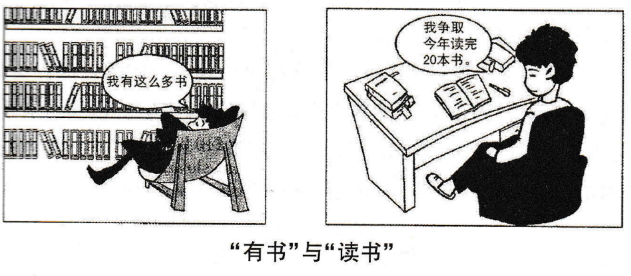Write an essay of 160-200 words based on the following pictures. In your essay, you should
describe the pictures briefly,
interpret the meaning, and
give your comments.
You should write neatly on the ANSWER SHEET. (20 points)

Part B
Write an essay of 160-200 words based on the following pictures. In your essay, you should
describe the pictures briefly,
interpret the meaning, and
give your comments.
You should write neatly on the ANSWER SHEET. (20 points)

0 / 160
【总体分析】:
图画寓意:“有书”不是目的,踏实“读书”才是,万事同理,空谈无益,实干才能进步。谋篇建议:首段描述图片;第二段明确图片所揭示的现象,并联系实际予以分析;末段提出建议,并表达期许。
【范文】:
In the left picture, a man says “What a great number of books I have!", yet obviously he shows no intention of reading any of them. The man on the right, by contrast, is sitting at a desk with only a few books on it, and has made a feasible reading plan: finish reading 20 books this year.
Through sharp contrast, the pictures reveal the difference between "possessing" and "reading" books. For some people, books are nothing more than decorations. Their studies are gorgeously decorated and shelves full of books used not to be read, but to satisfy their vanity, Totally differently, some people, fewer books though they have, regard books as spiritual food. For example, Lin Haiyin, a famous writer, has written that when she was young, she always went to a bookstore and read there in a secretive way for lack of money. It was the very thirst for knowledge that made for her a writer with great achievements.
Unread books won't help. We should read a single book carefully instead of merely collecting thousands of books. Furthermore, everything else should also be dealt with in adown-to-earth way. Only through continuing efforts can we advance steadily.
左图中,一个人说:“我有这么多书!”却明显没有要读任何一本书的打算。而右图中的人坐在只放着几本书的书桌前,做出了一个切实可行的读书计划:争取今年读完 20 本书。
图片通过鲜明的对比揭示了“有书”与“读书”的区别。对有些人来说,书籍只是一种装饰。他们把书房布置得富丽堂皇,书盈四壁,却不是为了读书,而是为了满足自己的虚荣心。与这种人截然不同的是,有些人虽然藏书不多,却把书籍当作精神食粮。比如著名作家林海音女士曾写过,小时候因为没钱买书,只能去一家书店偷偷读书。正是这种求知若渴的精神,使她日后成为了卓有成就的作家。
未读之书对人无所助益。我们要想取得进步,必须认认真真地去读一本书,而非仅仅收藏千万本书。另外,不仅是读书,做其他事情也应当脚踏实地。只有脚踏实地努力奋斗,才能取得稳定进步。
【写作模板】:
In the above picture appear(s) 图片中心人物/事物.
It reflects two distinct 图片浅层现象, which arise from different cognition in 深层原因. ________ in the left picture represents those who are ________, seeing ________ as ________. With this attitude, ________. In contrast, ________ in the right picture 行为, regarding ________ as ________. Such attitude has an energizing effect, leading to enormous success in ________. For example, ________.
As Seneca, an ancient Roman philosopher, once put it, “Almost any situation good or bad is affected by the attitude we bring to.”Therefore, it is advisable to ________.
________ 出现在上图中。
图片反应了两种截然不同的________,这两种方式源自于对于________的不同认知。左边的________代表那些________的人,他们把________看作________。抱着这种态度,________。相反,右边的________,他们把________看作________。这种态度有种激励效应,能够在________中带来巨大的成功。比如,________。
正如古罗马哲学家西尼加所说的那样:“任何一种处境--无论是好是坏--都受到我们面对处境的态度的影响。”因此,明智的做法是________。
【评分标准】:
评分时,先根据文章的内容和语言确定其所属档次,然后以该档次的要求来给分。评分人员在档内有1-3分的调节分。评分时酌情考虑拼写与标点符号对于正常交际和表达的影响程度,英、美拼写及词汇用法均可接受。
第一档
很好地完成了试题规定的任务(17-20分)
第二档
较好地完成了试题规定的任务(13-16分)
第三档
基本完成了试题规定的任务(9-12分)
第四档
未能按要求完成试题规定的任务(5-8分)
第五档
未完成试题规定的任务(1-4分)
零分档